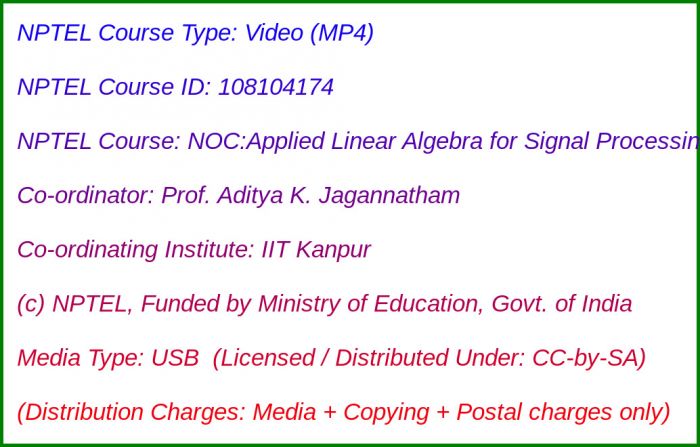NOC:Applied Linear Algebra for Signal Processing, Data Analytics and Machine Learning

Media Storage Type : 32 GB USB Stick
NPTEL Subject Matter Expert : Prof. Aditya K. Jagannatham
NPTEL Co-ordinating Institute : IIT Kanpur
NPTEL Lecture Count : 70
NPTEL Course Size : 7.2 GB
NPTEL PDF Text Transcription : Available and Included
NPTEL Subtitle Transcription : Available and Included (SRT)
Lecture Titles:
Lecture 1 - Vector Properties: Addition, Linear Combination, Inner Product, Orthogonality, Norm
Lecture 2 - Vectors: Unit Norm Vector, Cauchy-Schwarz inequality, Radar Application
Lecture 3 - Inner Product Application: Beamforming in Wireless Communication Systems
Lecture 4 - Matrices, Definition, Addition and Multiplication of Matrices
Lecture 5 - Matrix: Column Space, Linear Independence, Rank of Matrix, Gaussian Elimination
Lecture 6 - Matrix: Determinant, Inverse Computation, Adjoint, Cofactor Concepts
Lecture 7 - Applications of Matrices: Solution of System of Linear equations, MIMO Wireless Technology
Lecture 8 - Applications of Matrices: Electric Circuits, Traffic flows
Lecture 9 - Applications of Matrices: Graph Theory, Social Networks, Dominance Directed Graph, Influential Node
Lecture 10 - Null Space of Matrix: Definition, Rank-Nullity Theorem, Application in Electric Circuits
Lecture 11 - Gram-Schmidt Orthogonalization
Lecture 12 - Gaussian Random Variable: Definition, Mean, Variance, Multivariate Gaussian, Covariance Matrix
Lecture 13 - Linear Transformation of Gaussian Random Vectors
Lecture 14 - Machine Learning Application: Gaussian Classification
Lecture 15 - Eigenvalue: Definition, Characteristic Equation, Eigenvalue Decomposition
Lecture 16 - Special Matrices: Rotation and Unitary Matrices, Application: Alamouti Code
Lecture 17 - Positive Semi-definite (PSD) Matrices: Definition, Properties, Eigenvalue Decomposition
Lecture 18 - Positive Semidefinite Matrix: Example and Illustration of Eigenvalue Decomposition
Lecture 19 - Machine Learning Application: Principle Component Analysis (PCA)
Lecture 20 - Computer Vision Application: Face Recognition, Eigenfaces
Lecture 21 - Least Squares (LS) Solution, Pseudo-Inverse Concept
Lecture 22 - Least Squares (LS) via Principle of Orthogonality, Projection Matrix, Properties
Lecture 23 - Application: Pseudo-Inverse and MIMO Zero Forcing (ZF) Receiver
Lecture 24 - Wireless Application: Multi-Antenna Channel Estimation
Lecture 25 - Machine Learning Application: Linear Regression
Lecture 26 - Computation Mathematics Application: Polynomial Fitting
Lecture 27 - Least Norm Solution
Lecture 28 - Wireless Application: Multi-user Beamforming
Lecture 29 - Singular Value Decomposition (SVD): Definition, Properties, Example
Lecture 30 - SVD Application in MIMO Wireless Technology: Spatial-Multiplexing and High Data Rates
Lecture 31 - SVD for MIMO wireless optimization, water-filling algorithm, optimal power allocation
Lecture 32 - SVD application for Machine Learning: Principal component analysis (PCA)
Lecture 33 - Multiple signal classification (MUSIC) algorithm: system model
Lecture 34 - MUSIC algorithm for Direction of Arrival (DoA) estimation
Lecture 35 - Linear minimum mean square error (LMMSE) principle
Lecture 36 - LMMSE estimate and error covariance matrix
Lecture 37 - LMMSE estimation in linear systems
Lecture 38 - LMMSE application: Wireless channel estimation and example
Lecture 39 - Time-series prediction via auto-regressive (AR) model
Lecture 40 - Recommender system: design and rating prediction
Lecture 41 - Recommender system: Illustration via movie rating prediction example
Lecture 42 - Fast Fourier transform (FFT) and Inverse fast Fourier transform (IFFT)
Lecture 43 - IFFT/ FFT application in Orthogonal Frequency Division Multiplexing (OFDM) wireless technology
Lecture 44 - OFDM system: Circulant matrices and properties
Lecture 45 - OFDM system model: Transmitter and receiver processing
Lecture 46 - Single-carrier frequency division for multiple access (SC-FDMA) technology
Lecture 47 - Linear dynamical systems: definition and solution via matrix exponential
Lecture 48 - Linear dynamical systems: matrix exponential via SVD
Lecture 49 - Machine Learning application: Support Vector Machines (SVM)
Lecture 50 - Support Vector Machines (SVM): Problem formulation via maximum hyperplane separation
Lecture 51 - Sparse regression: problem formulation and relation to Compressive Sensing (CS)
Lecture 52 - Sparse regression: solution via the Orthogonal Matching Pursuit (OMP) algorithm
Lecture 53 - OMP Example for Sparse Regression
Lecture 54 - Machine Learning Application: Clustering
Lecture 55 - K-Means Clustering algorithm
Lecture 56 - Introduction to Stochastic Processes and Markov Chains
Lecture 57 - Discrete Time Markov Chains and Transition Probability Matrix
Lecture 58 - Discrete Time Markov Chain Examples
Lecture 59 - m-STEP Transition Probabilities for Discrete Time Markov Chains
Lecture 60 - Limiting Behavior of Discrete Time Markov Chains
Lecture 61 - Least Squares Revisited: Rank Deficient Matrix
Lecture 62 - Least Squares using SVD
Lecture 63 - Weighted Least Squares
Lecture 64 - Weighted Least Squares Example
Lecture 65 - Woodbury Matrix Identity - Matrix Inversion Lemma
Lecture 66 - Woodbury Matrix Identity - Proof
Lecture 67 - Conditional Gaussian Density - Mean
Lecture 68 - Conditional Gaussian Density - Covariance
Lecture 69 - Scalar Linear Model for Gaussian Estimation
Lecture 70 - MMSE Estimate and Covariance for the Scalar Linear Model

